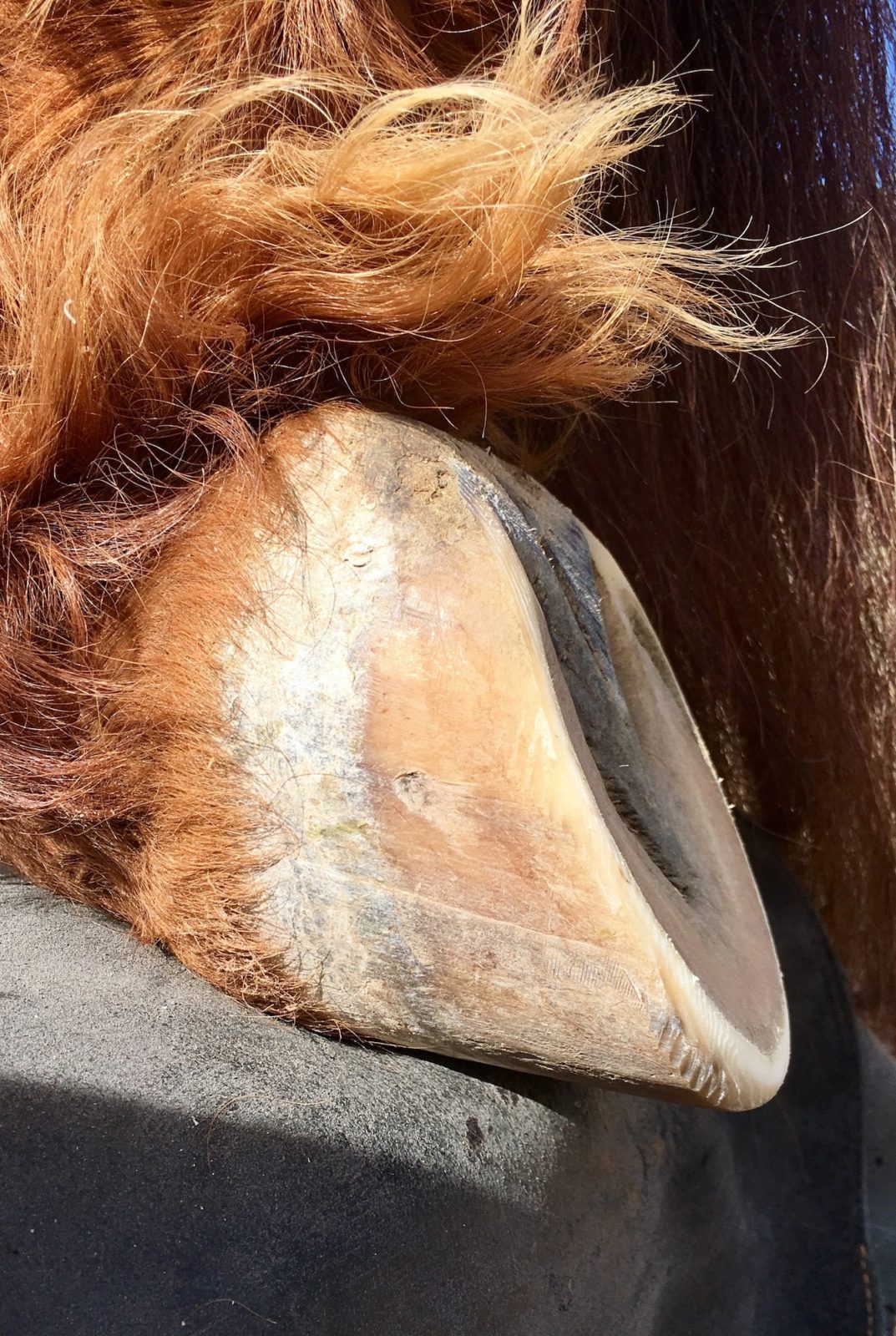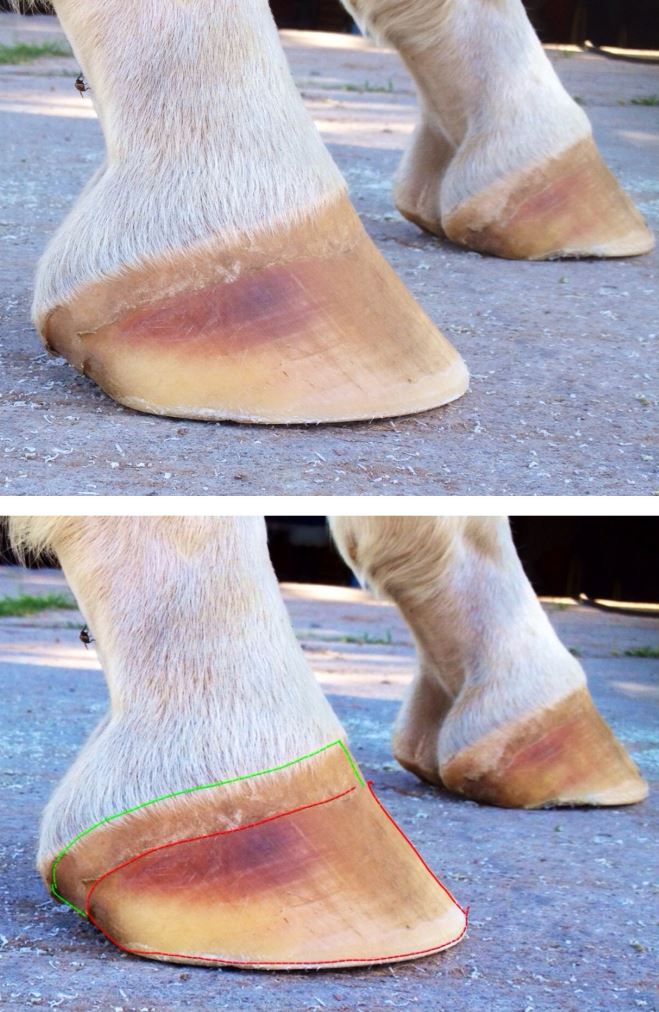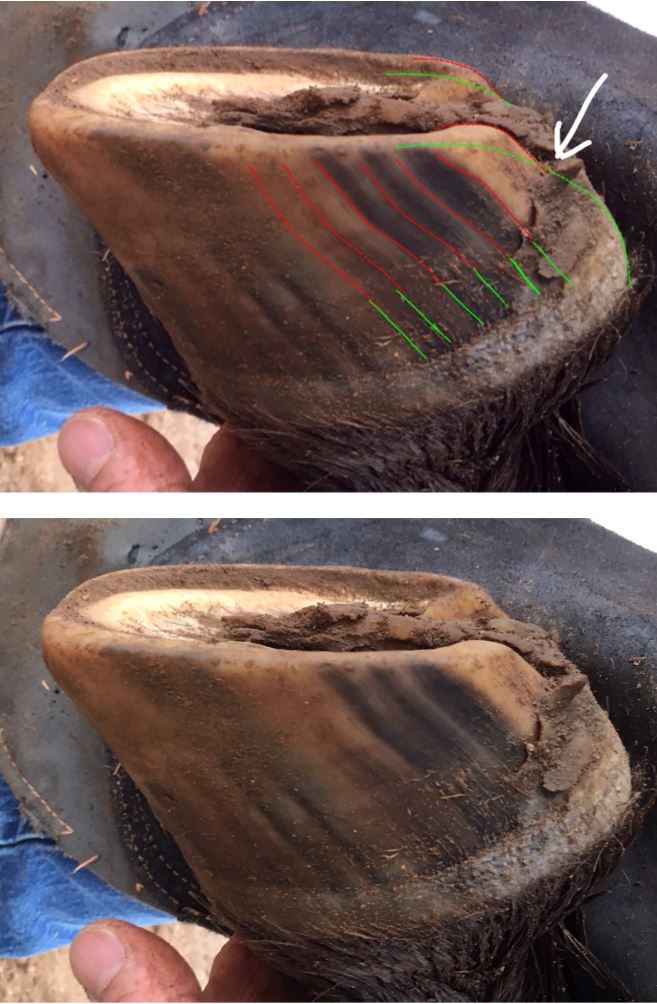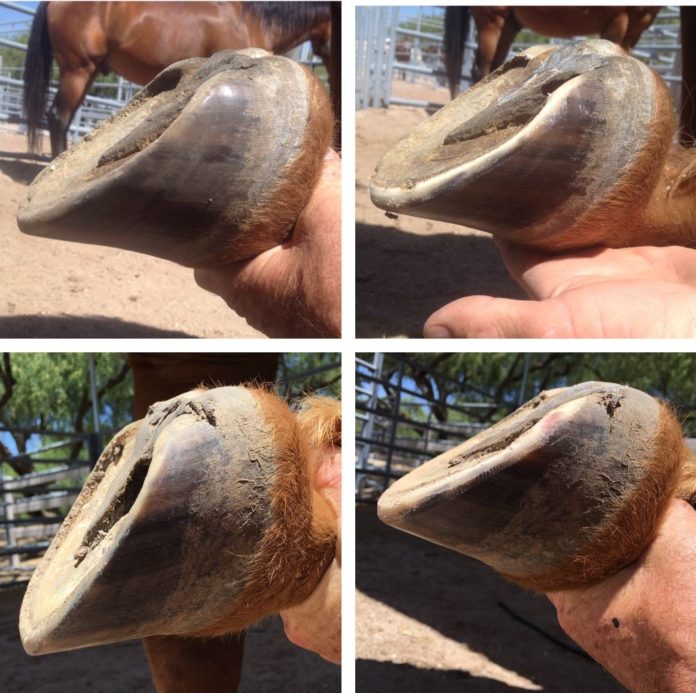Submitted by David Landreville of Landreville Hoof Care
There are a lot of trim methods out there teaching how to address heel height without mentioning heel shape. The shape of the heels are meant to change over a horse’s lifetime of use. When used properly they change in a much different way than if they are used improperly. While it is true that all horses have a unique hoof shape, they all have more in common than not. To understand this on a personal level, consider the equine foot being similar to the last digit on a human’s finger. Most human fingers are anatomically the same. They have the same function and similar nail growth rate, however, some humans have fat fingers with short nails and some have slender fingers with long nails. Some manicure their nails and keep them at optimum length with smooth edges so they don’t crack or chip and some work in the dirt and wear them down to nubs. It doesn’t matter whether you work with a shovel or a computer, how you repeatedly use your fingers will affect the way the nail is aligned with the finger and even the way the fingers are aligned on the hand, arm, and so on. I have wide hands with short fat fingers that work well for handling hooves and trimming tools. Personally, I’d rather have hands like Sting but we all have to make due with what we are given. This doesn’t necessarily mean that I couldn’t learn to play guitar or even be proficient at it, it just means I’m not naturally set up for it and may have to work harder to get there. The point is that all horses and humans have digits that produce a keratinized shell that provides strength and protection. They are recognizable by their shape and they have slight differences due to genetics, care, and use.
As far as horses are concerned, I don’t believe in any one human method of hoof trimming due to the fact that all humans have a unique perception so the method will be reinterpreted by everyone anyway. We all have something to contribute; some more than others and some are good examples of what not to do. It’s all valuable input.
It takes time to develop an eye for hoof distortion and even longer to develop an eye for hoof perfection. You have to see a lot of perfect hooves to build a mental model. Perfect hooves are rare and it takes years to develop them. It’s not very common for domestic horses to get the movement they need or have the kind of consistent hoof care that it takes to build these kinds of feet. What I’d like to share here is how I think heels should be shaped and how to assess whether the hoof shape is going in the right direction or not.
There is plenty of information out there on hoof anatomy so I won’t get too detailed on that. I will say that if you don’t put the time in on that you’ll be like me trying to play guitar. Once you understand the relationship between the heel horn and the corresponding soft tissue that it grows from, you’ll have to decide how much the heel supports the soft tissue or how much the soft tissue supports the heel. This perception may change as you develop your hoof care skills and start to see more and more bad feet turned into good feet. Hopefully, if you’re learning curve is on the vertical, there will be no boundaries to your perception, and you will get to observe good feet continuing to develop under your care. 
This hoof capsule is fully alive and perfectly aligned with with the internal structures.
The first thing to be aware of when assessing heels is how they transition from the soft tissue, that forms the heel bulbs, to the hard horn in the heel wall that wraps around the sole at each seat of corn. This return in the wall is known as the heel buttress and the part that makes contact with the ground is the heel purchase. As I said before, there are many online videos to watch and get a clearer picture of the inner structures. What’s important to me is a smooth transition from soft tissue to hard tissue. Faint lines turn into wrinkles, wrinkles turn into cracks, and cracks separate the hoof capsule from the inner structures. These visible symptoms disappear when the correct length of horn is distal to its origin of growth. This is what makes a horse choose to weight their heels and consequently build their caudal structures. Due to the rapid growth rate of the hoof wall, the heels can quickly become too long and depending on the conformation of the horse, they will either collapse or prop the horse up on stilts. The heel horn is meant to be fully alive and kept at an efficient length for optimum functionality. The larger the error, the more the horse has to compensate for it and horses are masters of un-detected compensation. Horses can perform amazing athletic feats with or without good feet. This is why so many suffer in silence until the breakdown is obvious.
The bottom line is that the profile of the heel should not have a flat spot or worse, a recurve. This is a telltale sign that the heels are too long and the soft tissues are being pushed up by the heels (this can be misinterpreted as being supported by the heel buttress). The recurve causes a “muffin top” appearance and that is exactly what is happening. Another term for this recurve is “navicular waist.” This is more commonly referred to on the hoof wall itself but it continues around the back of the foot through the transition between the heel bulbs and heel horn at the widest part of the frog. To make it more confusing, the widest part of the frog can become stretched, but this only makes the flat spot longer or the recurve more pronounced. This should make the problem more obvious. This condition indicates that the hoof capsule is not in alignment with its growth origins at P3 and the attached soft tissues. The hoof capsule is produced by the inner structures and in later stages of distortion, caused by the lack of growth/wear equilibrium, can actually mechanically separate from them causing a painful and difficult restoration process. A stretched heel is typically an indication of toe loading that causes stretching and/or tearing of the dorsal lamina as well as flattening of the sole that leads to P3 erosion (founder). This can be remedied, more easily in its earlier stages on most horses, by trimming in an anatomically meticulous way that allows the horse to fully use the entire solar surface of their feet in order to achieve and maintain optimum stride length. This will help them begin to correctly build their own true hoof shape through proper function.
Another way to view this distortion is to look for the appearance of one foot inside of the other. The new, supple, healthy growth being stuck inside of the old, hard, dead growth or simply put, “new foot versus old foot”. The new foot is seeking support from the ground and the horse is fixed on its toes by the still attached old foot that has become too tall. Due to the forward and downward growth of the hoof wall, the heel contact points migrate forward toward the middle of the foot as well as forward of the vertical line of the boney column. The heel buttresses become too long and the heel purchases become a pivot point instead of a proper support base. This can be compared to a human standing on the rung of a ladder. Anyone who has ever painted a tall wall while standing on an old style ladder with dowel shaped rungs should be able to sympathize. Many horses get stuck in a kind of “zombie” foot that’s half dead and half alive.

Green outlining new hoof and red outlining old hoof.
There is a common plateau where I see most horses and trimmers get stuck. Diet, footing, movement, and trimming can and should all be used to remedy this situation and to continue making progress. Some trimming methods prescribe a pre-determined heel height and some prescribe flattening the heel through the quarters to the widest part of the frog. These approaches can be too much or too little. This is where understanding the proper shape is an advantage. When you become more familiar with the internal structures of the foot, you may realize that there is not a sharp corner at the back of the heel (from a lateral perspective). It’s more of a rounded corner. In order for the back of the heels on the outer hoof capsule to remain in alignment with the growth origin at the adjacent spot on the internal structure where the origin of growth is, the corner must remain rounded. This would happen naturally with miles of wear from heel first landings, however, it is up to the trimmer to accurately simulate this wear pattern which is slightly different for every horse, every foot, and in every stage of development. This takes a lot of experience on the trimmer’s part to know just when and where to remove hoof horn in order to build sole and soft tissue. The frog has to be factored in and properly shaped as well or the horse still won’t commit their weight into the heels. The live frog should be full and supple and match the profile of the heels, never protruding past the heel purchase or have the appearance of buckling under or being stacked in layers. This is another sensitive area that relies on knowing exactly what to remove and what to leave. This can make the difference of a horse walking off better or worse. So many trimmers, understandably, play it safe and they tread lightly in an area that thrives on use and wear. Over time, this increases the heel length in the wrong area.
Heels should be assessed by dividing them into two parts: From the widest part of the frog (distally) to the ground and from the widest part of the frog (proximally) to the hairline or even above that to the top of the heel bulbs. The upper heel is regenerative soft tissue and the lower heel is degenerative horn. When the lower part is kept short, the upper part gets the stimulation that it needs to develop. Many trimmers theorize that this corner will wear on its own or that it needs to be there for a larger base of support. Rounding that corner allows the horse to rock back and get their weight over their heels. This can be one more step to improving the horse’s stance, increasing the horse’s stride length, and moving the foot out of limbo.
I follow three rules that have kept me, and the horses I trim, out of trouble and have increased my success rate:
- Never touch live sole.
- Minimize the amount of wall that protrudes beyond the peripheral edge of the sole.
- Don’t allow a sharp corner to develop between the widest part of the frog at the termination of the collateral grooves.
How you get to good feet will depend on many factors, but how can you fix or prevent what you don’t see?

(Above) White arrow points to the apex of the recurve.

(Above) Top photos: before and after trim showing the recurves heels and how I addressed them. Bottom photos: taken several months later showing the changes made in the transition of soft tissue to hard horn. This is the tail end of some corrections made over a 2 year period at 4 week trim intervals. The bruising in the heel purchase in the bottom right photo is from past trauma caused by the deviated (recurred) heel buttress crushing its own growth corium.

(Above) This is an example of how faint lines and creases indicate separation in its infancy. (Image on the left is a different horse in the beginning stage)
To read more of David Landreville’s educational writings, search his name on our blog or visit his Stuff That Works page.





